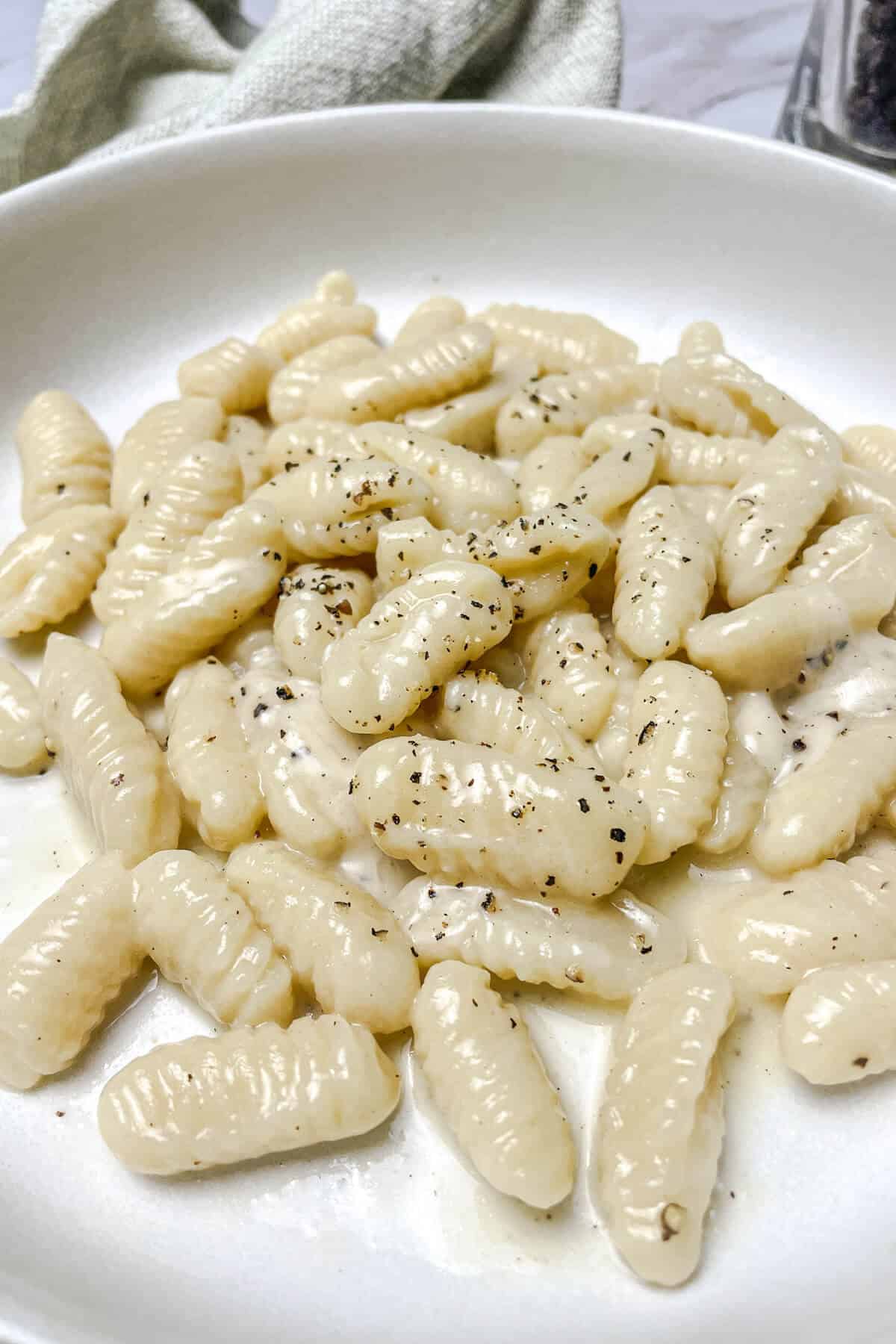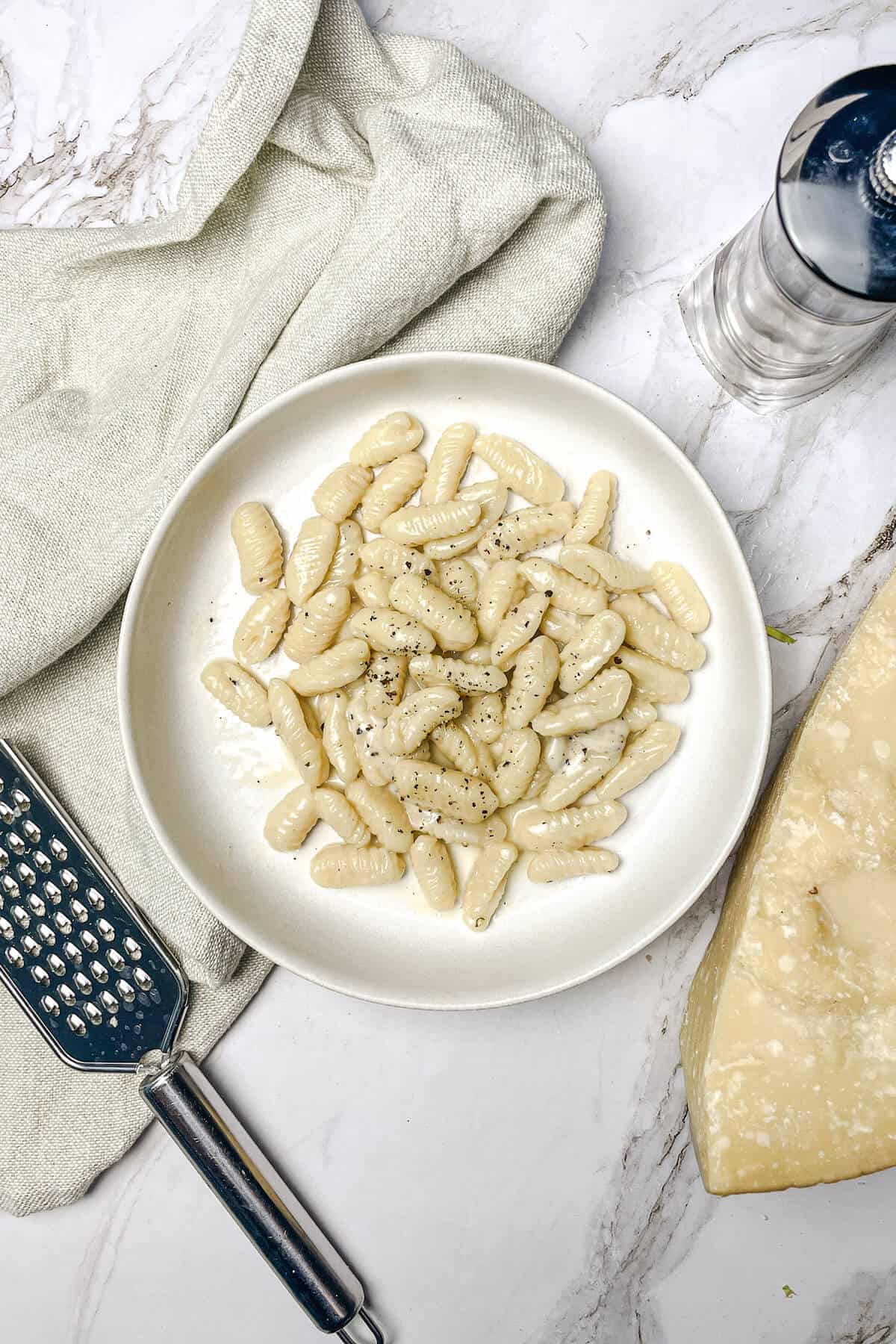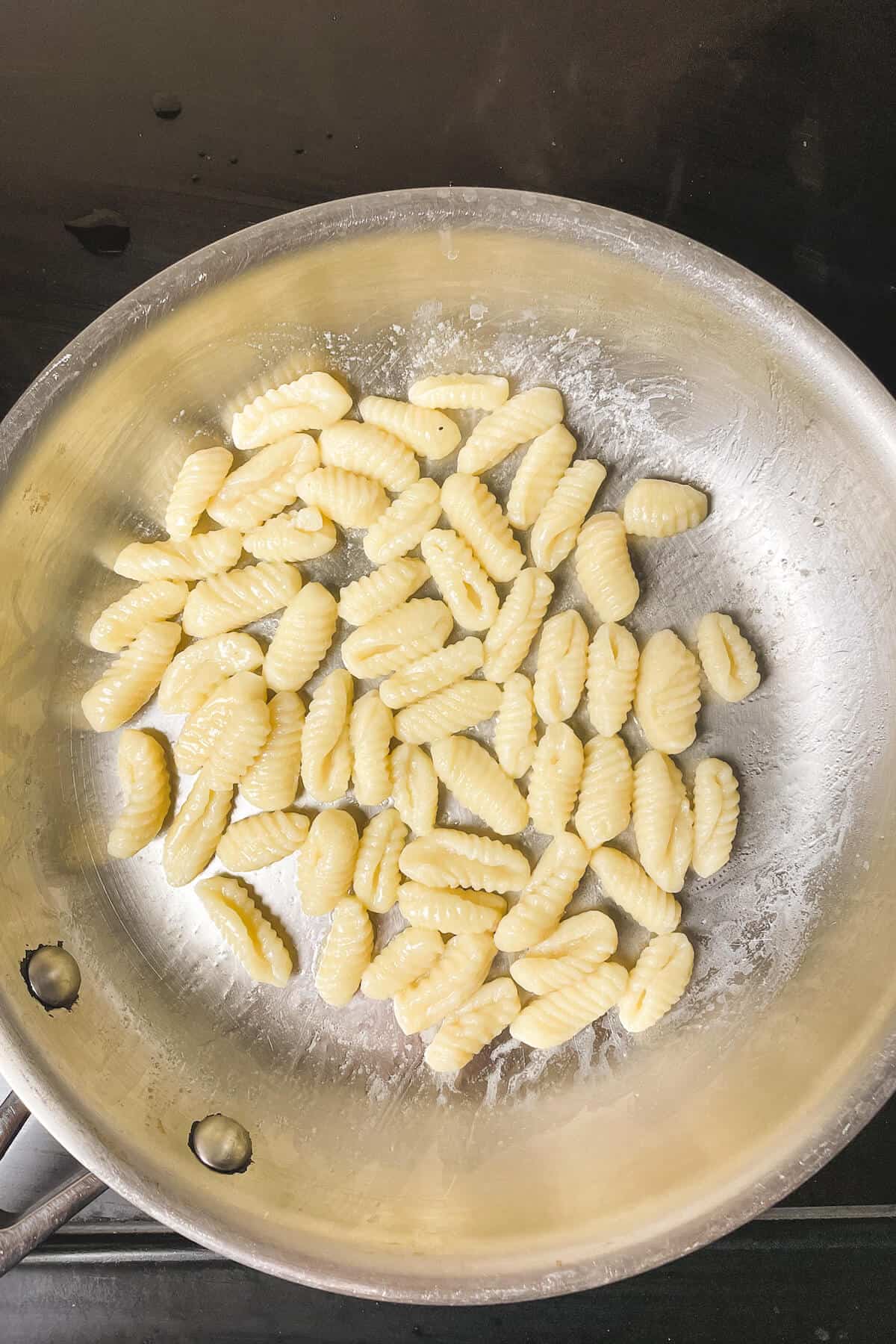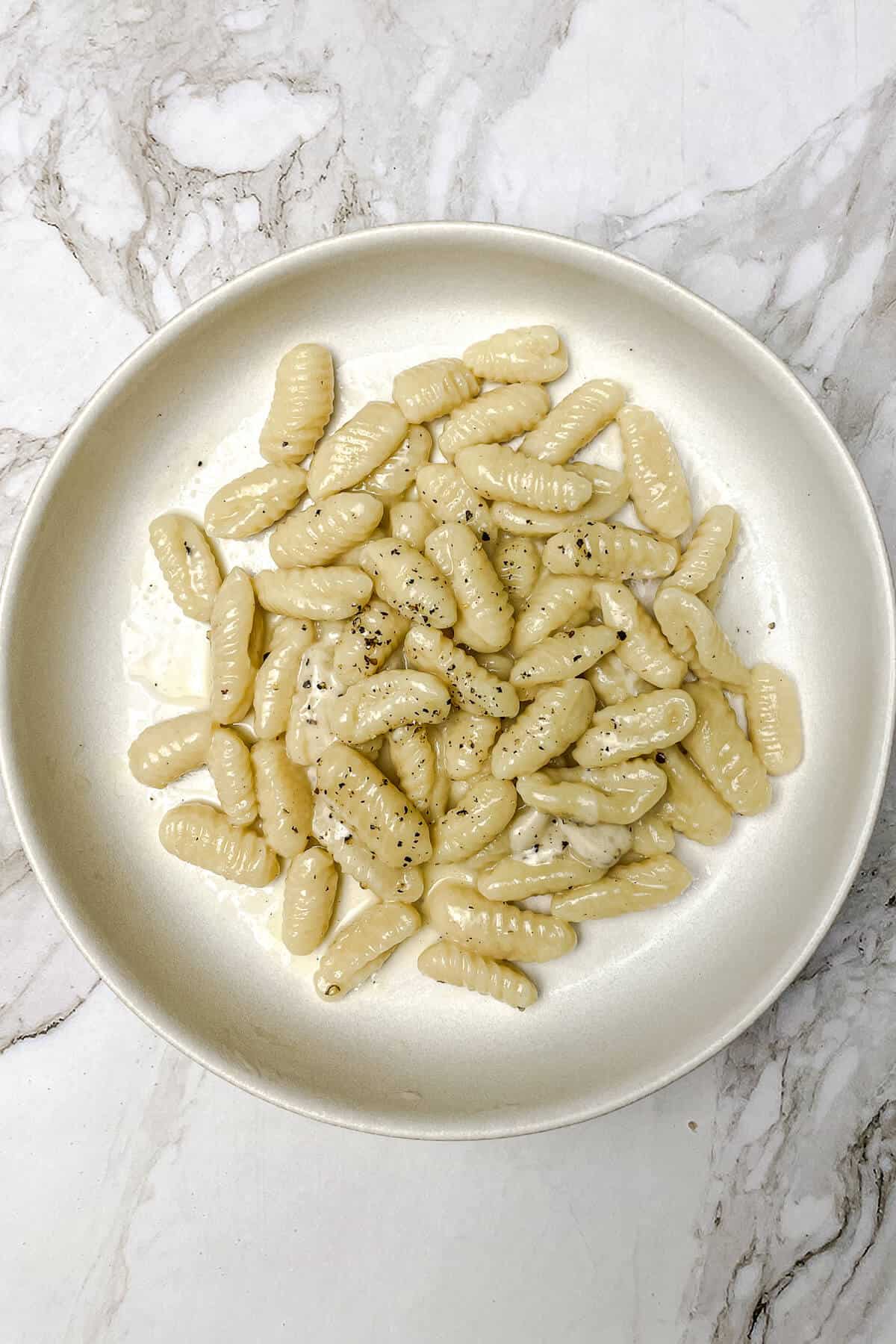This cavatelli cacio e pepe is the perfect weeknight dinner when you are in a hurry or really don’t feel like putting in much effort. You will find that many cacio e pepe recipes use heavy cream, but I choose to make this cavatelli cacio e pepe in the traditional way, which is without cream. That way it stays healthy and as easy as possible (because who has heavy cream sitting in their fridge at all times?). I find that if you use good quality cheese the sauce is so- luxurious and rich that you don’t need to add any extra cream. I hope you love this easy recipe as much as I do!

Why you’ll love this cavatelli cacio e pepe
- It is only 493 calories per serving, so it can be added to my weight-loss and weight-maintenance meal plans.
- It is creamy and filling and soooo satisfying.
- It takes less than 20 minutes to make.
- It only requires 4 simple, good quality ingredients that most people always have in their pantry.
- Your entire family will love it.
Ingredients you will need
- Hand-rolled cavatelli or store-bought cavatelli
- Butter – I prefer to use unsalted butter and add my own butter so that I control the amount of salt in the dish. However, if salted butter is all you have then that’s ok too! Just be aware of that as you are seasoning your dish.
- Finely grated, good quality Pecorino-Romano cheese – it should be finely grated so that it will melt easily into a sauce.
- Freshly ground black pepper – Always use fresh pepper, never ground black pepper when making cacio e pepe.
See recipe card for quantities.
Tools you will need
- Cheese grater (affiliate) with a fine grate
- Large pot
- Deep saute pan
- Slotted spoon
- Peppermill – if you do not have one of these things, stop what you are doing immediately and get one. I could not live without one and I find freshly ground black pepper elevates every dish.

Instructions
Start by bringing a large pot of generously salted water to a rolling boil. A general rule of thumb for salting pasta water is 1 tbsp salt for every 4 quarts of water. I know it seems almost uncomfortable how much salt that is, but don’t worry it will not be that salty!
Make sure you use a big pot so that the pasta has lots of room to move around in the water. This will help it cook faster and more evenly.
TOP TIP: Many home chefs believe that adding olive oil to the pasta water will keep your pasta from sticking together. I have tested this many times in the kitchen and have concluded that this is not true. The oil just ends up floating to the surface and adhering to the pasta when you take it out of the water. This inhibits the sauce from adhering to the pasta in the final step of making pasta, marrying the pasta and sauce together. This an important step every Italian chef takes each time they serve up a plate of pasta and should not be skipped! There is not need to waste your precious oil, especially if you are using high quality, expensive extra virgin olive oil. You can skip this step and save your oil and your wallet too.
If you are using store-bought cavatelli, cook the pasta for just shy of the recommended amount so your pasta is cooked al dente. Taste test along the way to ensure you’ve got the texture you desire. If you are using cavatelli you rolled by hand you may have to do some extra taste-testing (what a shame 😉) to get the right texture.
While the pasta is boiling, grate the cheese.

When your pasta is just about done being ready, heat a pan with a little bit of butter. Then, using your slotted spoon take the cavatelli out of the boiling water and add them directly to the pan. If you prefer to use a colander, just make sure you reserve about a ½ cup of the pasta water because it is a key element in this dish.

Using a measuring cup or a ladle add some of the starchy, salty pasta water directly into the pan along with the cavatelli. Then add the grated cheese to the pan, reserving a little bit for garnish if you desire. Toss everything together until the cheese melts and creates a thickened sauce that coats all of the pasta.
The last step is to add a generous amount of freshly grated pepper to the sauce. This is the “pepe” in cacio e pepe. You really shouldn’t need any additional salt because you added the salty pasta water to the sauce, but give it a taste just to make sure.
Now you are ready to serve. Serve immediately and eat it all, as this is not a dish that tastes better the next day. Enjoy it with a pinch of parm!

Substitutions and Additions
- Substitute the Cheese – Cacio e pepe is a dish that comes from the south of Italy, and like most southern dishes, it is traditionally made with a cheese from sheep’s milk called Pecorino-Romano. It has a much sharper flavour compared to Parmigiano-Reggiano, which some people don’t like. If you are one of these people, you can absolutely substitute it for Parmigiano-Reggiano. You can even do a mixture of half Pecorino and half parmigiano to soften up the sharpness of the Pecorino. It’s your dish so trying out different options and see what you prefer. Keep in mind that Pecorino is a little more salty than Parmigiano, so you may need to add a little extra Parmigiano to keep the salt levels the same.
- Substitute the pasta – if you don’t have cavatelli on hand you can use any dry pasta you have in the pantry with this recipe. However, there are a few types of pasta that are recommended for this dish, like spaghetti, linguine or ricotta gnocchi.
- Add creaminess – If you are looking for something extra creamy you can choose to add either more butter or a small amount of heavy cream to the dish. Keep in mind that this will change the calories per serving calculated in this recipe.
- Add garlic – I love garlic in everything, so if you are the same you can try sautéing a clove or two of garlic in the hot pan before you add the pasta. Although this is not the traditional way to make cacio e pepe, who cares if it tastes good!
- Add protein – If you’re feeling like you need to get some protein into this dish try adding some crispy prosciutto, guanciale, pancetta or even bacon. Keep in mind this will change the calories per serving of this dish.
Wine Pairings
Although it seems that this dish might be light on the palate because it’s only made with 3 simple ingredients, it packs a lot of flavour! The sharpness of the pecorino and loads of freshly ground black pepper suggest a full-bodied white, like a buttery chardonnay, or a medium-bodied peppery red, like a Malbec, would pair well. Here are a few suggestions:
- Fattoria Aldobrandesca, Vie Cave Maremma Toscana, Tuscany, Italy
- Cabreo, La Pietra Chardonnay, Tuscany, Italy
- Four Shadows Chardonnay, Okanagan Valley
- Mission Hill Family Estate, Reserve Chardonnay, Okanagan Valley, Canada
- Anthill Farms, Peter’s Vineyard Syrah, Sanoma Valley, USA
- Saviah, Malbec, Walla Walla Valley, USA
- Big Table Farm, The Wild Bee Chardonnay, Willamette Valley, USA
Storage
Cavatelli cacio e pepe is meant to be served and eaten right away, and does not make the best leftovers. However, if you simply made too much, you could store it in the fridge for up to 3 days.
To reheat add the pasta to a hot pan with some butter. You may have to add a little bit of water to the sauce to loosen it up.
FAQ
Cacio e pepe comes from a time when eggs were hard to come by in southern Italy and people had to make do with what they had. Both cacio e pepe and carbonara contain Pecorino-Romano cheese and pepper. However, carbonara has the additional ingredients of guanciale, a cured meat back from pork cheeks, and eggs to form the base of the sauce.
Related
Looking for other recipes like this? Try these:
Pairing
These are my favorite dishes to serve with cavatelli cacio e pepe:

Cavatelli cacio e pepe
Equipment
- Cheese grater (affiliate) with a fine grate
- Large pot
- Large pan
- Slotted spoon
- Pepper mill
Ingredients
- 450 grams hand-rolled cavatelli or one package store-bought cavatelli
- ½ cup finely grated good quality Pecorino-Romano plus more for garnish
- 2 tsp freshly ground pepper plus more to taste
- 2 tbsp butter
- 1/2 cup pasta water
Instructions
- Bring salted water to a rolling boil in a large pot over medium-high heat. Add the cavatelli and cook until al dente.
- When the pasta is just about cooked to your liking, heat a pan with the butter over medium-low heat.
- Use a slotted spoon to remove the cavatelli form the boiling water and add it directly to the pan.
- Add about ½ cup of the pasta water to the pan. Then add the grated cheese into the pan and mix it together with the pasta and water until it forms a slightly thick sauce and coats all the pasta.
- Add the freshly grated pepper and cook for about one minute. Taste and add more salt and pepper if needed.
- Plate and serve immediately. Garnish with additional cheese and pepper as desired.
Leave a Reply